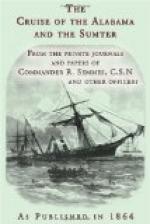“The ship Louisa Hatch, from Cardiff to West Indies, we burned. The ship Dorcas Prince, with a general cargo, we burned. The ship Sea Lark, with a general cargo from the East Indies, we burned. The barque Union Jack, from Boston to Shanghai, we burned. We captured a Yankee consul on board of her; he was on his way to Foochin; we landed him at the Brazils. The ship Gildersliene, from New York to the East Indies, we burned. The barque Justina we released on bond, to take home prisoners. The ship Jabez Snow, from New York to the East Indies, we burned. The barque Amazonian, from Boston to Buenos Ayres, we burned. The ship Talisman, from New York to the East Indies, we burned. The barque Conrad, fitted up as a Federal cruiser, a tender to a man-of-war, we captured and burned. After these came the Anne F. Schmidt, mentioned before, and the Sea Bride—and the Sea Bride you saw us take to-day. The estimated value of these captures is 4,200,000 dollars.”
The American Consul, Mr. Graham, has handed to his Excellency the Governor a protest against the capture of the Sea Bride, on the ground that the vessel was in British waters at the time of her being stopped by the Alabama. His Excellency told Mr. Graham that the decision of the case remained purely on evidence, but he would see there was no breach of neutrality. The Captain of the Sea Bride says he is prepared to show by bearings that he was within two and a half miles of Robben Island.
No. VI.
CORRESPONDENCE RESPECTING THE TUSCALOOSA.
Rear-Admiral Sir B. Walker to the Secretary to the Admiralty. August 19, 1863.
I beg you will be pleased to acquaint my Lords Commissioners of the Admiralty with the following particulars relative to the proceedings of the Confederate States ships of war Alabama, her reported tender Tuscaloosa, and the Georgia, which have recently arrived at the Cape of Good Hope.
2. On the 28th of July an English schooner arrived in Table Bay, and reported that on the previous day she had been boarded by the Confederate steamer Alabama, fifteen miles north-west of Green Point. After some inquiries the Alabama left her, steering south-east.




